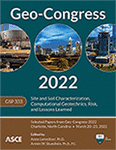On the Influence of Physico-Chemical Phenomena on Shear Strength of Consolidated Kaolinite
Publication: Geo-Congress 2022
ABSTRACT
At the same effective stress, shear strength of consolidated clays is a function of the stress history. Normally consolidated clay specimens tend to contract upon shearing while overconsolidated clays tend to dilate. Moreover, overconsolidated clays have a peak shear strength while normally consolidated clays plateau to their critical state. In this study, two-dimensional (2D) discrete element method (DEM) simulations for kaolinite at different stress histories are presented. Clay particles are modelled as rigid rods (clumps) in a two-dimensional framework, with different sizes replicating the actual particle size distribution of the kaolinite used later for model validation. The nonlinear nature of contact between clay particles is simplified by introducing linear springs at the particles’ contact to simulate van der Waals attractive and double layer repulsive forces. A series of numerical simulations at different stress histories and effective stresses is presented. The observed shearing behavior at different stress histories is discussed in light of microstructural changes before shearing. Results suggest particle orientations, and therefore the physico-chemical forces prior to shearing might have minimal impact on shear strength, while the void ratio is the main factor controlling the shearing behavior.
Get full access to this article
View all available purchase options and get full access to this chapter.
REFERENCES
Anandarajah, A., and Chen, J. (1994). “Double Layer Repulsive Force between Two Inclined Platy Particles Accroding to the Gouy-Chapman Theory.” Journal of Colloid and Interface Science, 168(1), 111–117.
Anandarajah, A., and Chen, J. (1997). “Van der Waal Attractive Force Between Clay Particles in Water and Contaminants.” Soils and Foundations, 37(2), 27–37.
Belheine, N., Plassiard, J., Donze´, F., Darve, F., and Seridi, A. (2009). “Numerical simulation of drained triaxial test using 3D discrete element modeling.” Computers and Geotechnics, 36(1), 320–331.
Chapman, D. L. (1913). “a contribution to the theory of electrocapilarity.” Phylosiphical magazine, 25(6), 475–481.
Cui, L., O’sullivan, C., and O’neill, S. (2007). “An analysis of the triaxial apparatus using a mixed boundary three-dimensional discrete element model.” Géotechnique, 57(10), 831–844.
Cundall, P. A., and Strack, O. D. L. (1979). “A discrete numerical model for granular assemblies.” Géotechnique, 29(1), 47–65.
Derjaguin, B. (1934). “Analysis of friction and adhesion IV The theory of the adhesion of small particles.” Kolloid Zeitschriit, 69(2), 155–164.
Derjaguin, B. V., and Landau, L. (1941). “Theory of the stability of strongly charged lyophobic sols and of the adhesion of strongly charged particles in solutions of electrolytes.” Acta Physicochimica, 14(1), 633–662.
Dzyaloshinskii, I. E., Lifshitz, E. M., and Pitaevskii, L. P. (1961). “General Theory of Van der Waal Forces.” Soviet physics, 73(3-4), 153–176.
Gouy, G. (1910). “Sur la constitution de la charge electrique a la surface d’un electrolyte.” Anniue physique (Paris), 9(1), 457–468.
Jaradat, K. A., Darbari, Z., Elbakhshwan, M., Abdelaziz, S. L., Gill, S. K., Dooryhee, E., and Ecker, L. E. (2017). “Heating-freezing effects on the orientation of kaolin clay particles.” Applied Clay Science, 150, 163–174.
Jaradat, K. A., and Abdelaziz, S. L. (2019). “On the Use of Discrete element Method for Multi-Scale Assessment of Clay Behavior.” Computers and Geotechnics, 112(1), 329–341.
Jaradat, K. A., and Abdelaziz, S. L. (2020). “Impact of Particle Size Distribution on Drained Shearing Response of Saturated Clays Using Discrete Element Method. ” In Geo-Congress 2020: Modeling, Geomaterials, and Site Characterization, ASCE, Reston, VA, 302–310.
Lambe, T. W. (1958). “The structure of compacted clay.” Journal of the Soil Mechanics and Foundation Division: Proceeding of the American Society of Civil Engineers, 58(2), 1–34.
London, Z. (1937). “The general theory of molecular forces.” Transcation of the Faraday Society, 33(1), 8–26.
Mitchell, J. K., and Soga, K. (2005). Fundamentals of Soil Behavior, Hoboken, NJ, John Wiley & Sons, Inc., 592 p.
O’sullivan, C. (2011). Particulate discrete element modelling: a geomechanics perspective, Taylor and Francis.
PFC2D. 2019. Particle flow code in three-dimensions. Itasca Consulting Group,. 6.0 ed. Minneapolis, USA.
Santamarina, J. C., and Fam, M. (1995). “Changes in dielectric permittivity and shear wave velocity durinf concentration diffusion.” Canadian Geotechnical Journal, 32(4), 647–659.
Seed, H. B., and Chan, C. K. (1959). “Structure and strength characteristics of compacted clays.” Journal of the Soil Mechanics and Foundation Division: Proceeding of the American Society of Civil Engineers, 1(1), 87–128.
Van Olphen, H. (1977). An introduction to clay colloid chemistry, New York, 318 p., John Wiley & Sons, Inc.
Verwey, E. J., and Overbeek, J. T. G. (1948). Theory of Stability of Lyophobic Colloids, Elsevier, Amesterdam.
Yao, M., and Anandarajah, A. (2003). “Three-dimensional discrete element method of analysis of clays.” Journal of Engineering Mechanics-Asce, 129(6), 585–596.
Yimsiri, S., and Soga, K. (2010). “DEM analysis of soil fabric effects on behaviour of sand.” Géotechnique, 60(6), 483–495.
Information & Authors
Information
Published In
History
Published online: Mar 17, 2022
Authors
Metrics & Citations
Metrics
Citations
Download citation
If you have the appropriate software installed, you can download article citation data to the citation manager of your choice. Simply select your manager software from the list below and click Download.
